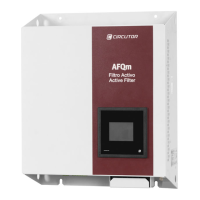36
AFQm
Instruction Manual
3.8.1.- CONNECTING INDIVIDUAL DEVICES
To connect multiple individual devices in parallel, follow these steps:
1.- Select the device that will operate as the “master”.
2.- Connect the “master” device. The current transformers are only connected to the “master” device.
3.- Connect all of the “slave” devices.
Note: Each devices must feature the protection elements indicated in section “3.5.- CONNECTION”.
4.- Connect all of the devices using the communication cables (Table 16).
Table 16: Communication cable, devices in parallel.
Communication cable
RJ11 connector Pinout
4
1
1: Not connected.
2: CAN A
3: CAN B
4: Not connected.
Note: The communication cable must be a CAT 5 cable or higher.
Connect the OUT terminal from the “master” filter to the IN terminal from the second filter, the OUT
terminal from the second filter to the IN terminal of the third, and so on (Figure 30).
OUT
IN
2
3
2
3
ON
RBUS
OUT
IN
2
3
2
3
ON
RBUS
ON
RBUS
Figure 30:Connecting 3 devices in parallel, using the communication cable.
5.- Configure the installation in the “master” device (see “7. CONFIGURATION”
6.- Complete the configuration of the slave devices (see “7.- CONFIGURATION”).
7.- Enable the terminator switch for parallel connection, RBUS (Terminal No 2 of Table 12 and Table 13)
in the bus end devices only. Then disable in the other devices.

